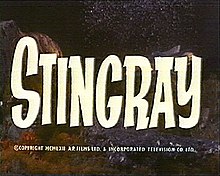| Stingray | |
|---|---|
 | |
| Genre | Children's science fiction[1] |
| Created by | Gerry and Sylvia Anderson |
| Written by |
|
| Directed by |
|
| Voices of |
|
| Music by | Barry Gray |
| Opening theme | "Stingray" |
| Ending theme | "Aqua Marina", sung by Gary Miller |
| Country of origin | United Kingdom |
| Original language | English |
| No. of series | 1 |
| No. of episodes | 39 |
| Production | |
| Producer | Gerry Anderson |
| Cinematography | John Read |
| Editors |
|
| Running time | 25 minutes |
| Production company | AP Films in association with ATV |
| Budget | £20,000 per episode |
| Original release | |
| Network | ITV |
| Release | 4 October 1964 – 27 June 1965 |
| Infobox instructions (only shown in preview) | |
Stingray is a British children's science fiction television series created by Gerry and Sylvia Anderson and produced by AP Films (APF) for ITC Entertainment. Filmed in 1963 using a combination of electronic marionette puppetry and scale model special effects, it was APF's sixth puppet series and the third to be produced under the banner of "Supermarionation". It premiered in October 1964 and ran for 39 half-hour episodes.
Set in the 2060s, the series follows the exploits of the World Aquanaut Security Patrol (WASP), an organisation responsible for policing the Earth's oceans. The WASP's flagship is Stingray, a combat submarine crewed by Captain Troy Tempest, navigator Lieutenant "Phones" and Marina, a mute young woman from under the sea. Stingray's adventures bring it into contact with various underwater civilisations, some friendly and others hostile, as well as strange natural phenomena.
In preparation for the series, APF acquired new, larger studios that it would continue to occupy for the remainder of the 1960s. Filmed at a cost of approximately £1 million,[2] Stingray was claimed to be the first British TV series to be made entirely in colour,[3][4] a move intended to increase its appeal to the lucrative American market.[5][6][7] However, when the colour aspect was publicised in the 1960s this claim was protested by artist and puppeteer Francis Coudrill, who claimed he had made his cowboy puppet series The Stoopendus Adventures of Hank "in full colour" for Associated-Rediffusion several years previously.[8] The underwater sequences were filmed "dry" by shooting the sets through thin aquaria, while surface shots were filmed on water tanks incorporating lowered back walls to create artificial horizons. Stingray was the first Supermarionation series whose puppet characters had interchangeable heads showing a range of facial expressions.
Stingray was originally broadcast on the ITV network in the United Kingdom and in syndication in North America. The series has drawn a largely positive response from commentators, some of whom have compared its premise to the Cold War.
- ^ Evans, Jeff (2006) [2001]. The Penguin TV Companion. Penguin Reference (3rd ed.). London, UK: Penguin Books. p. 786. ISBN 978-0-141-02424-0.
- ^ O'Brien, p. 80.
- ^ Bentley 2008, p. 80.
- ^ La Rivière, p. 96.
- ^ Rogers et al., p. 68.
- ^ Peel, p. 240.
- ^ Cite error: The named reference
SangsterCondonwas invoked but never defined (see the help page). - ^ "Hank Says He Was The First". The Stage. London. 3 September 1964. p. 13.